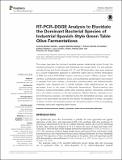Por favor, use este identificador para citar o enlazar a este item:
http://hdl.handle.net/10261/147586COMPARTIR / EXPORTAR:
 SHARE SHARE
 CORE
BASE CORE
BASE
|
|
| Visualizar otros formatos: MARC | Dublin Core | RDF | ORE | MODS | METS | DIDL | DATACITE | |

| Título: | RT-PCR-DGGE analysis to elucidate the dominant bacterial species of industrial Spanish-style green table olive fermentations |
Autor: | Benítez-Cabello, Antonio CSIC ORCID ; Bautista-Gallego, J. CSIC ORCID ; Garrido Fernández, A. CSIC ORCID ; Rantsiou, Kalliopi; Cocolin, Luca; Jiménez Díaz, Rufino CSIC ORCID ; Arroyo López, Francisco Noé CSIC ORCID | Palabras clave: | Bacterial biodiversity Lactobacillus Marine salt RT-PCR-DGGE Table olives Biofilms |
Fecha de publicación: | 2016 | Editor: | Frontiers Media | Citación: | Frontiers in Microbiology 7 (2016) | Resumen: | This paper describes the dominant bacterial species metabolically active through the industrial production of Spanish-style Manzanilla and Gordal olives. For this purpose, samples (brines and fruits) obtained at 0, 15, and 90 fermentation days were analyzed by a culture-independent approach to determine viable cells by reverse transcription of RNA and further PCR-DGGE analysis, detecting at least 7 different species. Vibrio vulnificus, Lactobacillus plantarum group, and Lactobacillus parafarraginis were present in samples from both cultivars; Lactobacillus sanfranciscensis and Halolactobacillus halophilus were detected only in Gordal samples, while Staphylococcus sp. was exclusively found at the onset of Manzanilla fermentations. Physicochemical data showed a typical fermentation profile while scanning electron microscopy confirmed the in situ biofilm formation on the olive epidermis. Different Bacillus, Staphylococcus, and Enterococcus species, not detected during the fermentation process, were also found in the solid marine salt used by the industry for preparation of brines. Elucidation of these non-lactic acid bacteria species role during fermentation is then an appealingly challenge, particularly regarding safety issues. | URI: | http://hdl.handle.net/10261/147586 | DOI: | 10.3389/fmicb.2016.01291 | Identificadores: | doi: 10.3389/fmicb.2016.01291 issn: 1664-302X |
| Aparece en las colecciones: | (IG) Artículos |
Ficheros en este ítem:
| Fichero | Descripción | Tamaño | Formato | |
|---|---|---|---|---|
| fmicb_2016_V7_01291.pdf | 2,04 MB | Adobe PDF |  Visualizar/Abrir |
CORE Recommender
PubMed Central
Citations
9
checked on 17-mar-2024
SCOPUSTM
Citations
16
checked on 18-abr-2024
WEB OF SCIENCETM
Citations
17
checked on 26-feb-2024
Page view(s)
273
checked on 19-abr-2024
Download(s)
195
checked on 19-abr-2024

